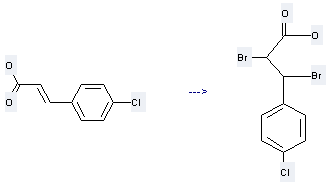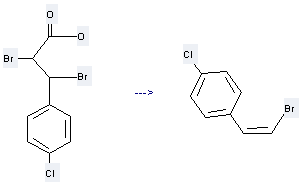-
Name
2,3-DIBROMO-3-(4-CHLOROPHENYL)PROPANOIC ACID
- EINECS
- CAS No. 24653-99-4
- Article Data27
- CAS DataBase
- Density 1.981 g/cm3
- Solubility
- Melting Point 187℃
- Formula C9H7Br2ClO2
- Boiling Point 357.1 °C at 760 mmHg
- Molecular Weight 342.414
- Flash Point 169.8 °C
- Transport Information
- Appearance Light yellow solid
- Safety
- Risk Codes
-
Molecular Structure
- Hazard Symbols
- Synonyms Hydrocinnamicacid, a,b-dibromo-p-chloro- (8CI);NSC 122941;2,3-Dibromo-3-(4-chlorophenyl)propanoic acid;2,3-Dibromo-3-(p-chlorophenyl)propionic acid;
- PSA 37.30000
- LogP 3.62410
2,3-Dibromo-3-(4-chlorophenyl)propanoic acid Specification
The Benzenepropanoicacid, α,β-dibromo-4-chloro- is an organic compound with the formula C9H7Br2ClO2. The IUPAC name of this chemical is 2,3-Dibromo-3-(4-chlorophenyl)propanoic acid. With the CAS registry number 24653-99-4, it is also named as 2,3-Dibromo-3-(p-chlorophenyl)propionic acid. The categories of the product are Aromatics Compounds; Aromatics. Besides, its molecular weight is 342.41. And it is light yellow solid.
The physical properties of Benzenepropanoicacid, α,β-dibromo-4-chloro- are: (1)ACD/LogP: 4.24; (2)ACD/LogD (pH 5.5): 1.04; (3)ACD/LogD (pH 7.4): 0.51; (4)ACD/BCF (pH 5.5): 1; (5)ACD/BCF (pH 7.4): 1; (6)ACD/KOC (pH 5.5): 3.05; (7)ACD/KOC (pH 7.4): 1; (8)#H bond acceptors: 2; (9)#H bond donors: 1; (10)#Freely Rotating Bonds: 3; (11)Polar Surface Area: 26.3 Å2; (12)Index of Refraction: 1.64; (13)Molar Refractivity: 62.31 cm3; (14)Molar Volume: 172.8 cm3; (15)Polarizability: 24.7×10-24 cm3; (16)Surface Tension: 60.3 dyne/cm; (17)Density: 1.981 g/cm3; (18)Flash Point: 169.8 °C; (19)Enthalpy of Vaporization: 63.57 kJ/mol; (20)Boiling Point: 357.1 °C at 760 mmHg; (21)Vapour Pressure: 1.01E-05 mmHg at 25 °C.
Preparation: this chemical can be prepared by 3-(4-Chloro-phenyl)-acrylic acid. This reaction will need reagent bromine and solvent CCl4. The yield is about 80%.

Uses of Benzenepropanoicacid, α,β-dibromo-4-chloro-: it can be used to produce (Z)-p-Chloro-β-bromostyrene. It will need reagent NaHCO3 and solvent acetone. The yield is about 91%.

You can still convert the following datas into molecular structure:
(1)SMILES: Clc1ccc(cc1)C(Br)C(Br)C(=O)O
(2)InChI: InChI=1/C9H7Br2ClO2/c10-7(8(11)9(13)14)5-1-3-6(12)4-2-5/h1-4,7-8H,(H,13,14)
(3)InChIKey: VVMCVHQTBODLRQ-UHFFFAOYAI
(4)Std. InChI: InChI=1S/C9H7Br2ClO2/c10-7(8(11)9(13)14)5-1-3-6(12)4-2-5/h1-4,7-8H,(H,13,14)
(5)Std. InChIKey: VVMCVHQTBODLRQ-UHFFFAOYSA-N
Related Products
- 20,22-DIHYDRODIGITOXIN
- 20,29,30-Trinorlupane,(17alpha)-
- 20-ETHYL-6-β,8-DIHYDROXY-1-α-METHOXY-4-METHYLHETERATISAN-14-ONE
- 20-Ethylprostaglandin F2-alpha
- 20-Isopropylcholanthrene
- 20-METHYLCHOLANTHREN-15-ONE
- 20-METHYLCHOLANTHRENE PICRATE
- 20-METHYLCHOLANTHRENE-TRINITRO-BENZENE
- 20(S)-Ginsenoside C-K
- 2,10-DIFLUOROBENZO(rst)PENTAPHENE
- 246543-68-0
- 24654-48-6
- 24654-55-5
- 24655-82-1
- 2465-59-0
- 24656-24-4
- 24658-24-0
- 2465-93-2
- 2466-09-3
- 24662-37-1
Hot Products
About|Contact|Cas|Product Name|Molecular|Country|Encyclopedia
Message|New Cas|MSDS|Service|Advertisement|CAS DataBase|Article Data|Manufacturers | Chemical Catalog
©2008 LookChem.com,License: ICP
NO.:Zhejiang16009103
complaints:service@lookchem.com Desktop View